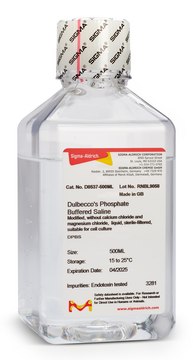Wichtige Dokumente
H9394
Hanks-Salze -Lösung
Modified, with sodium bicarbonate, without calcium chloride and magnesium sulfate, liquid, sterile-filtered, suitable for cell culture
Synonym(e):
HBSS
About This Item
Empfohlene Produkte
Sterilität
sterile-filtered
Form
liquid
Methode(n)
cell culture | mammalian: suitable
Verunreinigungen
endotoxin, tested
Komponenten
NaHCO3: 0.35 g/L
glucose: 1.0 g/L (Dextro)
phenol red: 0.011 g/L
Versandbedingung
ambient
Suchen Sie nach ähnlichen Produkten? Aufrufen Leitfaden zum Produktvergleich
Allgemeine Beschreibung
Anwendung
- als Komponente des Kulturmediums zur Kultivierung von kortikalen Scheiben der Maus
- als Komponente des Dissoziationspuffers für die Inkubation von humanen induzierten pluripotenten Stammzellen (hiPSC) und hiPSC-abgeleiteten Kardiomyozyten (CM)
- für die In-situ-Perfusion von Mäuseleber
Biochem./physiol. Wirkung
Ergänzung
Lagerklassenschlüssel
12 - Non Combustible Liquids
WGK
WGK 1
Flammpunkt (°F)
Not applicable
Flammpunkt (°C)
Not applicable
Hier finden Sie alle aktuellen Versionen:
Besitzen Sie dieses Produkt bereits?
In der Dokumentenbibliothek finden Sie die Dokumentation zu den Produkten, die Sie kürzlich erworben haben.
Kunden haben sich ebenfalls angesehen
Protokolle
StableCell™ Trypsin solutions are designed to perform cell detachment as standard trypsin solutions do, without the need to aliquot, freeze, and thaw. This saves significant time before passaging.
Trypsin may be used to remove adherent cells from a culture surface. Cells are most commonly removed from the culture substrate by treatment with trypsin or trypsin/EDTA solutions.
Unser Team von Wissenschaftlern verfügt über Erfahrung in allen Forschungsbereichen einschließlich Life Science, Materialwissenschaften, chemischer Synthese, Chromatographie, Analytik und vielen mehr..
Setzen Sie sich mit dem technischen Dienst in Verbindung.






